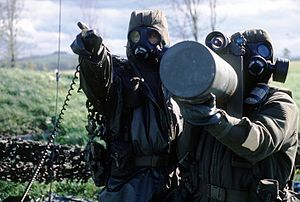| Blowpipe | |
|---|---|
 A Canadian missile detachment of 129th Airfield Air Defence Battery, RCA, with Blowpipe during NATO Exercise Cornet Phaser in 1987. The soldiers are wearing Nuclear, Biological and Chemical (NBC) protective gear. | |
| Type | Man-portable air-defense systems |
| Place of origin | United Kingdom |
| Service history | |
| In service | 1975 to 1985[1] |
| Used by | See Operators |
| Wars | Falklands War Soviet–Afghan War Gulf War Cenepa War |
| Production history | |
| Designer | Short Brothers |
| Designed | 1975 |
| Manufacturer | Short Brothers |
| Produced | 1975 to 1993[1] |
| No. built | 34,382[1] |
| Specifications | |
| Mass | 14.5 kg (32 lb) (missile in launch tube) 22 kg (49 lb) (complete system) 6.2 kg (14 lb) (launcher) |
| Length | 1.35 m (4 ft 5 in) |
| Diameter | 76 mm (3.0 in) |
| Crew | 1 |
| Effective firing range | 0.5 to 3.5 km (0.31 to 2.17 mi) |
| Warhead | Shaped charge |
| Warhead weight | 2.2 kg (4.9 lb) |
| Engine | Solid rocket motor |
| Maximum speed | Mach 1.5 |
Guidance system | MCLOS system |
The Shorts Blowpipe is a man-portable (MANPADS) surface-to-air missile that was in use with the British Army and Royal Marines from 1975 to 1985. It also saw service in other military forces around the world. Most examples were retired by the mid-1990s. It is unique among MANPADS in that it is manually guided to its target with a small joystick, sending guidance corrections to the missile over a radio control link.
Blowpipe underwent a protracted and controversial development between the programme's initial conception in 1966 and 1975 when it finally entered service. It had its first use during active combat in the Falklands War in 1982 when it was used by both sides of the conflict. Its demonstrated performance was poor, with only two confirmed kills.
As a result of the poor performance of the system, an improved version offering semi-automatic guidance was introduced as Javelin. This was further improved with a laser designator system in Javelin S15, which was later renamed Starburst. Both Javelin systems were used only briefly before being replaced by the dramatically more powerful Starstreak in the 1990s.
Several advanced variants and alternative launchers, including a submarine-based system, did not see production. Approximately 35,000 missiles were produced in total.
- ^ a b c Forecast International Archived 27 September 2007 at the Wayback Machine Blowpipe